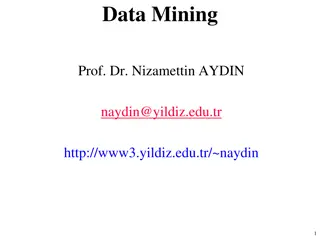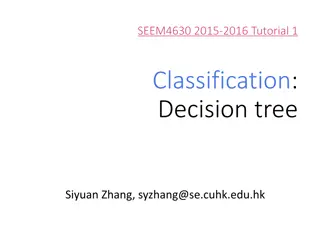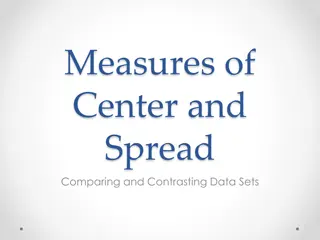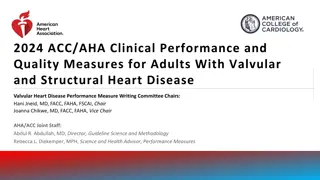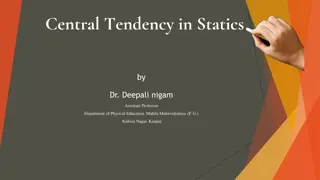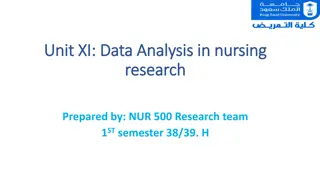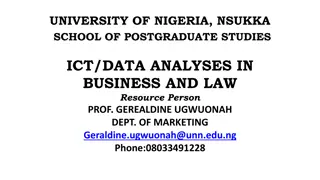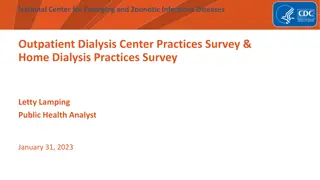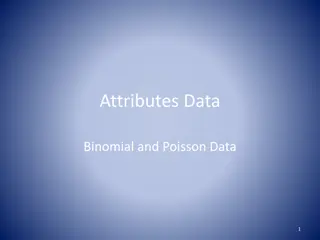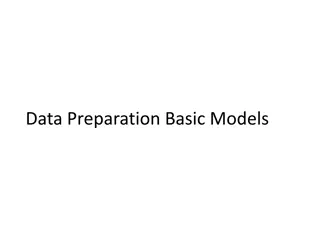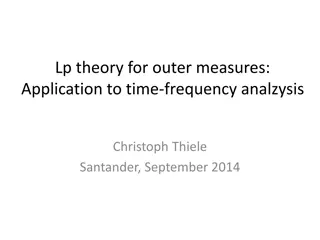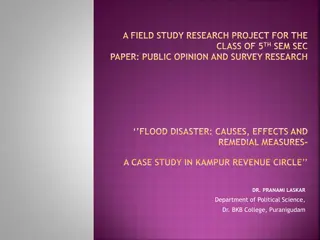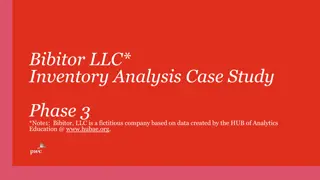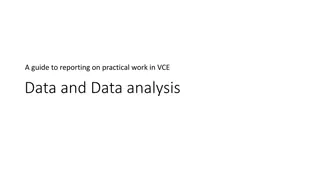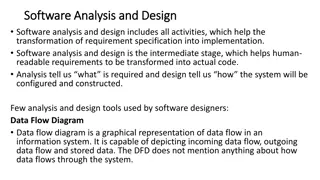Understanding Measures of Center in Data Analysis
This lesson explores the concept of measuring the center of a distribution of quantitative data using the median and the mean. It covers how to find and interpret the median, calculate the mean, compare both measures, and choose the appropriate measure of center. Practical examples and explanations are provided to enhance understanding. By the end of this lesson, you will be able to confidently analyze and describe the center of data distributions in statistical contexts.
Download Presentation

Please find below an Image/Link to download the presentation.
The content on the website is provided AS IS for your information and personal use only. It may not be sold, licensed, or shared on other websites without obtaining consent from the author. Download presentation by click this link. If you encounter any issues during the download, it is possible that the publisher has removed the file from their server.
E N D
Presentation Transcript
Analyzing One-Variable Data Lesson 1.6 Measuring Center Statistics and Probability with Applications, 3rdEdition Starnes, Tabor Bedford Freeman Worth Publishers
Measuring Center Learning Targets After this lesson, you should be able to: Find and interpret the median of a distribution of quantitative data. Calculate the mean of a distribution of quantitative data. Compare the mean and median of a distribution, and choose the more appropriate measure of center in a given setting. Statistics and Probability with Applications, 3rd Edition 2 2
Measuring Center Here are the travel times in minutes of 20 randomly chosen New York workers, along with a dotplot of the data: The distribution is right-skewed and single-peaked. The longest travel time (85 minutes) appears to be an outlier. How should we describe where this (or some other) distribution of quantitative data is centered? The two most common ways to measure center are the median and the mean. Statistics and Probability with Applications, 3rd Edition 3 3
Measuring Center We could report the value in the middle of a distribution as its center. That s the idea of the median. Median The median is the midpoint of a distribution, the number such that about half the observations are smaller and about half are larger. To find the median, arrange the data values from smallest to largest. If the number n of data values is odd, the median is the middle value in the ordered list. If the number n of data values is even, the median is the average of the two middle values in the ordered list. Statistics and Probability with Applications, 3rd Edition 4 4
Did your heart step it up? Did your heart step it up? Finding and interpreting the median when Finding and interpreting the median when n n is even PROBLEM: Fourteen students in another statistics class were asked to stand beside their desks and measure their heart rate while standing. The data are shown below, measured in beats per minute. Find the median and interpret this value in context. is even 73 75 87 65 69 62 81 64 68 101 74 71 89 87 SOLUTION: First arrange the data in order: 62 64 65 68 69 71 73 74 75 81 87 87 89 101 Since there are n = 14 data values (an even number), the median is the average of the two middle values in the ordered list, or ??+?? About half of the students have heart rates less than 73.5 bpm and about half have heart rates greater than 73.5 bpm. = ??.? ???. ? Statistics and Probability with Applications, 3rd Edition 5 5
Measuring Center The most common measure of center is the mean. Mean x The mean (pronounced x-bar )of a quantitative set of data is the average of all n data values. To find the mean, add all the values and divide by n. That is, x =sum of data values n In mathematics, the capital Greek letter sigma, , is short for add them all up. Therefore, the formula for the mean can be written in more compact notation: x =x1+x2+...+xn n xi = n Statistics and Probability with Applications, 3rd Edition 6 6
Living together or apart? Living together or apart? Finding the mean Finding the mean PROBLEM: Here are the population densities (in number of people per square kilometer) for the seven countries in Central America, along with a dotplot: Population density (per km ) Country Belize Costa Rica El Salvador Guatemala Honduras Nicaragua Panama 13 82 292 129 67 44 44 (a) Calculate the mean population density for these 7 countries. Show your work. ? = ?? ? ? =?? + ?? + ??? + ??? + ?? + ?? + ?? = ??.? ?????? ??? ??? Statistics and Probability with Applications, 3rd Edition 7 7
Living together or apart? Living together or apart? Finding the mean Finding the mean PROBLEM: Here are the population densities (in number of people per square kilometer) for the seven countries in Central America, along with a dotplot: Population density (per km ) Country Belize Costa Rica El Salvador Guatemala Honduras Nicaragua Panama 13 82 292 129 67 44 44 (b) The dotplot above suggests that El Salvador might be an outlier. Ignore El Salvador for a moment and recalculate the mean for the remaining 6 countries. How does this mean compare to the mean you calculated for all 7 countries? ? = ?? ? ? El Salvador increases the mean population density of Central American countries by 32.7 people per square kilometer. =?? + ?? + ??? + ?? + ?? + ?? = ??.? ?????? ??? ??? Statistics and Probability with Applications, 3rd Edition 8 8
Measuring Center Which measure the mean or the median should we report as the center of a distribution? That depends on both the shape of the distribution and whether there are any outliers. Resistant A measure of center (or variability) is resistantif it isn t influenced by unusually large or unusually small values in a distribution. The mean is not resistant to outliers. The median is resistant to outliers. Statistics and Probability with Applications, 3rd Edition 9 9
Measuring Center Choosing a Measure of Center If a distribution of quantitative data is roughly symmetric and has no outliers, use the mean to measure center. If the distribution is strongly skewed or has outliers, use the median to measure center. Statistics and Probability with Applications, 3rd Edition 10 10
Do you carry a big stick? Do you carry a big stick? Comparing the mean and median Comparing the mean and median PROBLEM: In 2004, the Boston Red Sox won their first World Series in 86 years, breaking the so-called Curse of the Bambino. There were many memorable moments in this World Series including a red moon resulting from a partial lunar eclipse on the night that the Red Sox won the final game. The dotplot below shows the batting averages of the Red Sox starting lineup for Game 3, including designated hitter (DH) David Ortiz, and Game 3 starting pitcher Pedro Martinez. Median = 0.295 x = 0.262 (a) Explain why the mean is so much smaller than the median. The mean is pulled toward the long tail in this left-skewed distribution. The outlier of 0.000 lowers the mean but does not affect the median as much. Statistics and Probability with Applications, 3rd Edition 11 11
Do you carry a big stick? Do you carry a big stick? Comparing the mean and median Comparing the mean and median PROBLEM: In 2004, the Boston Red Sox won their first World Series in 86 years, breaking the so-called Curse of the Bambino. There were many memorable moments in this World Series including a red moon resulting from a partial lunar eclipse on the night that the Red Sox won the final game. The dotplot below shows the batting averages of the Red Sox starting lineup for Game 3, including designated hitter (DH) David Ortiz, and Game 3 starting pitcher Pedro Martinez. Median = 0.295 x = 0.262 (b) Which measure of center better describes a typical batting average for these players? Explain. Because the distribution of batting averages is skewed to the left and has an outlier, the median batting average of 0.295 better summarizes the center of the distribution. The mean batting average, 0.262, does not reflect a typical batting average. Only 1 of the 10 players has a batting average less than or equal to 0.262. Statistics and Probability with Applications, 3rd Edition 12 12
LESSON APP 1.6 Is the pace of life slower in smaller cities? Does it take less time to get to work in smaller cities? Here are the travel times in minutes for 15 workers in North Carolina, chosen at random by the Census Bureau, along with a dotplot of the data. 1. Find the median. Interpret this value in context. 2. Calculate the mean travel time. Show your work. 3. Which measure of center the median or the mean better describes a typical travel time to work for this sample of workers in North Carolina? Justify your answer. Statistics and Probability with Applications, 3rd Edition 13 13
LESSON APP 1.6 Is the pace of life slower in smaller cities? Statistics and Probability with Applications, 3rd Edition 14 14
Measuring Center Learning Targets After this lesson, you should be able to: Find and interpret the median of a distribution of quantitative data. Calculate the mean of a distribution of quantitative data. Compare the mean and median of a distribution, and choose the more appropriate measure of center in a given setting. Statistics and Probability with Applications, 3rd Edition 15 15



